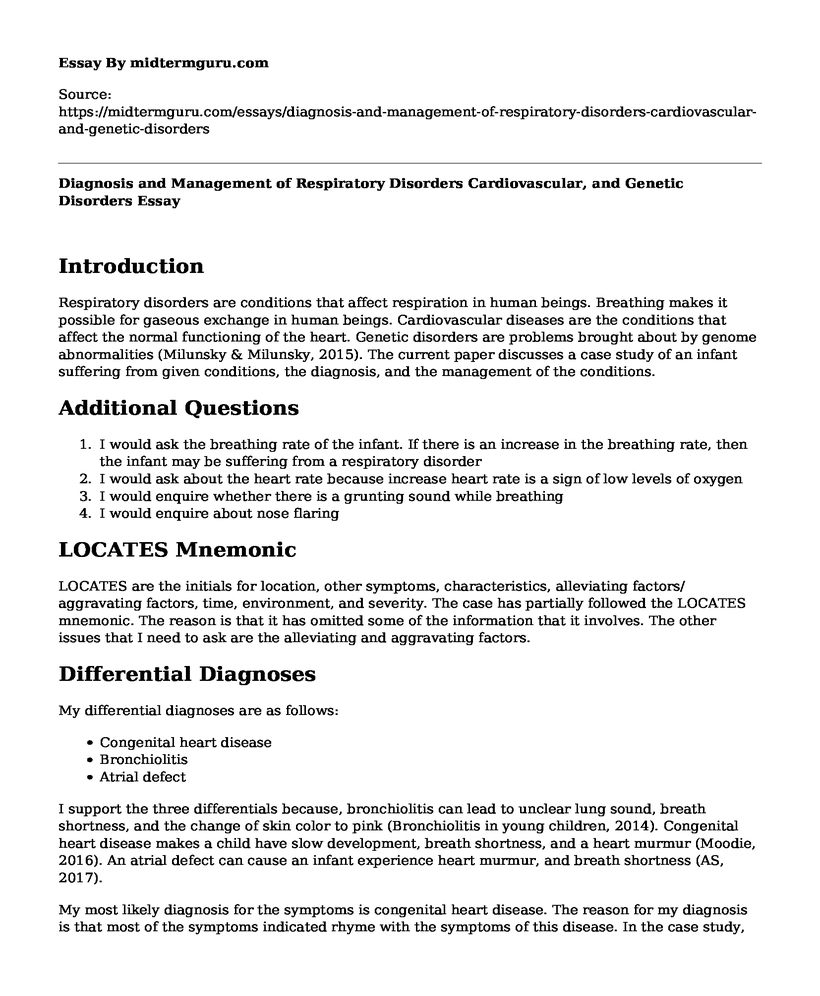Introduction
Respiratory disorders are conditions that affect respiration in human beings. Breathing makes it possible for gaseous exchange in human beings. Cardiovascular diseases are the conditions that affect the normal functioning of the heart. Genetic disorders are problems brought about by genome abnormalities (Milunsky & Milunsky, 2015). The current paper discusses a case study of an infant suffering from given conditions, the diagnosis, and the management of the conditions.
Additional Questions
- I would ask the breathing rate of the infant. If there is an increase in the breathing rate, then the infant may be suffering from a respiratory disorder
- I would ask about the heart rate because increase heart rate is a sign of low levels of oxygen
- I would enquire whether there is a grunting sound while breathing
- I would enquire about nose flaring
LOCATES Mnemonic
LOCATES are the initials for location, other symptoms, characteristics, alleviating factors/ aggravating factors, time, environment, and severity. The case has partially followed the LOCATES mnemonic. The reason is that it has omitted some of the information that it involves. The other issues that I need to ask are the alleviating and aggravating factors.
Differential Diagnoses
My differential diagnoses are as follows:
- Congenital heart disease
- Bronchiolitis
- Atrial defect
I support the three differentials because, bronchiolitis can lead to unclear lung sound, breath shortness, and the change of skin color to pink (Bronchiolitis in young children, 2014). Congenital heart disease makes a child have slow development, breath shortness, and a heart murmur (Moodie, 2016). An atrial defect can cause an infant experience heart murmur, and breath shortness (AS, 2017).
My most likely diagnosis for the symptoms is congenital heart disease. The reason for my diagnosis is that most of the symptoms indicated rhyme with the symptoms of this disease. In the case study, there is a symptom showing slow development, difficulty in breathing, ejection murmur, and pink skin, which are all signs of congenital heart disease.
Treatment
I would treat the condition using the catheter procedure. The catheter procedure is better because it does not need surgery. The doctor punctures the skin using a needle and then inserts the catheter into an artery or a vein to the septum. The device is retrieved from the catheter once it reaches the septum, and a hole is made between the atria. The catheter then gets removed from the body (Moodie, 2016). The medications to be administered include antiplatelets, bosentan, digoxin, diuretics, warfarin, anticoagulants, antiarrhythmics, and ACE inhibitors.
Educating Parents
Parents whose children get diagnosed with congenital heart disease go through a hard period of stress. Parental stress is a condition that has affects these parents whose children suffer from the disease. The situation has been studied, although not broadly in health education.
Programs should be set up for parents of these infants. The programs work in strengthening them and supporting them. The programs should teach the parents how to overcome the fears of losing their children to the dangerous disease. The programs also help in solving the problems that the parents may be facing. Inadequate cultural support by the extended family is a social-cultural barrier that may affect the treatment and management process of this condition.
The influenza vaccine should get administered to children for a congenital heart defect. The next well visit should be after one month. A cold virus immunization should follow in the future well visit (Moodie, 2016). The anticipatory guidance that should get provided is education to parents on how to observe possible signs if the condition persists after leaving the hospital.
References
AS, C. (2017). Interrupted Inferior Vena Cava with Atrial Septal Defect. BAOJ Paediatrics, 3(3). doi: 10.24947/baojpd/3/3/142
Bronchiolitis in young children. (2014). The Pharmaceutical Journal. doi: 10.1211/pj.2014.20067177
Milunsky, A., & Milunsky, J. M. (2015). Genetic disorders and the fetus: diagnosis, prevention, and treatment. John Wiley & Sons. https://books.google.co.ke/books?hl=en&lr=&id=WkVICgAAQBAJ&oi=fnd&pg=PR9&dq=genetic+disorders&ots=d49qHImDJT&sig=nU3sQadTSdwiYkAZorZvKnr_siQ&redir_esc=y#v=onepage&q=genetic%20disorders&f=false
Moodie, D. (2016). The Journal Congenital Heart Disease-2016. Congenital Heart Disease, 11(1), 5-6. doi: 10.1111/chd.12342
Cite this page
Diagnosis and Management of Respiratory Disorders Cardiovascular, and Genetic Disorders. (2022, Sep 12). Retrieved from https://midtermguru.com/essays/diagnosis-and-management-of-respiratory-disorders-cardiovascular-and-genetic-disorders
If you are the original author of this essay and no longer wish to have it published on the midtermguru.com website, please click below to request its removal:
- Paper Example on DNA Repair as a Critical Tumor Suppressor Function
- Essay Saple on Organ Selling
- Foster Care: Temporary Placement for Children Who Cannot Live With Families - Research Paper
- Jean Watson's Philosophy of Care: Benefits of Nursing Education - Essay Sample
- Abortion: Common, Safe, Yet Criminally Prohibited in Australia - Essay Sample
- Nurses Leverage Research to Improve Quality Care - Research Paper
- Managing Cancer Risk: Smoking and Avoids Relapse - Essay Sample







